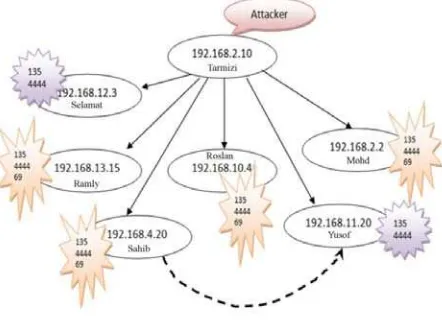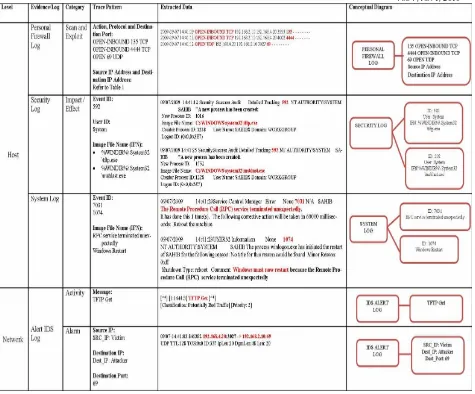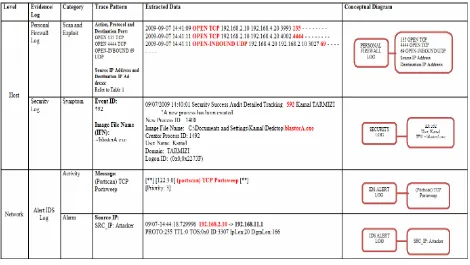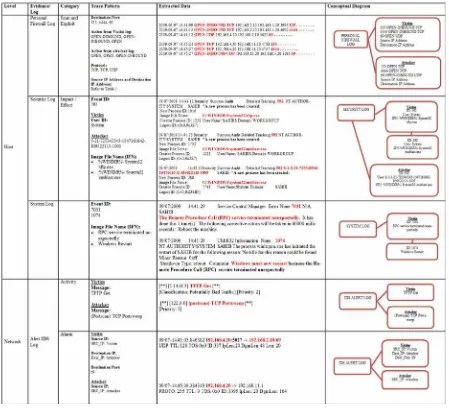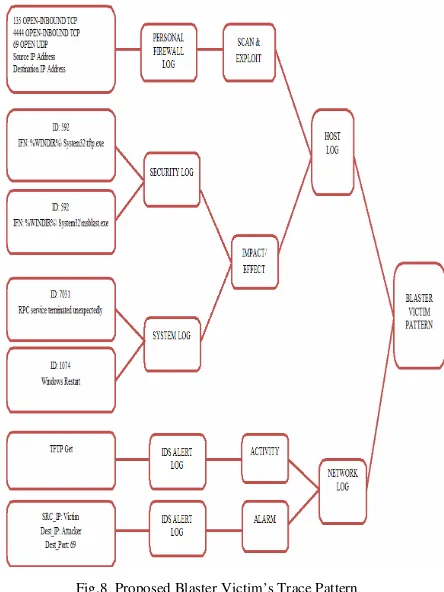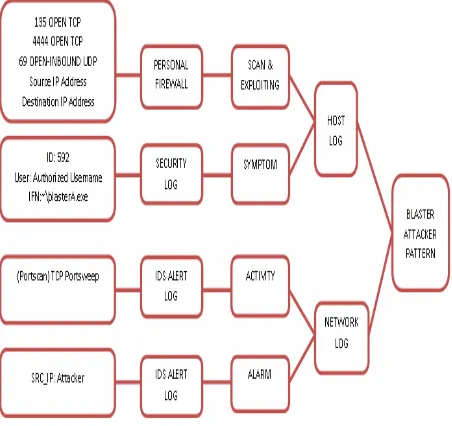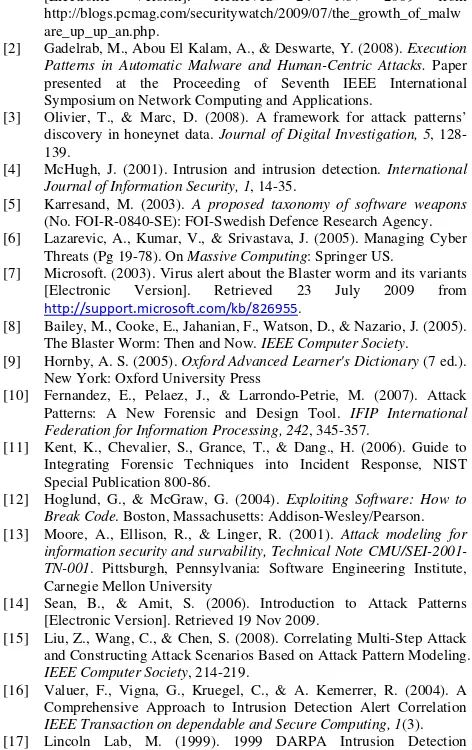Vol. 7, No. 1, 2010
SCENARIO BASED WORM TRACE PATTERN
IDENTIFICATION TECHNIQUE
Siti Rahayu S., Robiah Y., Shahrin S., Mohd Zaki M., Irda R., Faizal M. A. Faculty of Information and Communication Technology
Univeristi Teknikal Malaysia Melaka, Durian Tunggal, Melaka,
Malaysia .
Abstract—The number of malware variants is growing tremendously and the study of malware attacks on the Internet is still a demanding research domain. In this research, various logs from different OSI layer are explore to identify the traces leave on the attacker and victim logs, and the attack worm trace pattern are establish in order to reveal true attacker or victim. For the purpose of this paper, it will only concentrate on cybercrime that caused by malware network intrusion and used the traditional worm namely blaster worm variants. This research creates the concept of trace pattern by fusing the attacker’s and victim’s perspective. Therefore, the objective of this paper is to propose on attacker’s, victim’s and multi-step (attacker/victim)’s trace patterns by combining both perspectives. These three proposed worm trace patterns can be extended into research areas in alert correlation and computer forensic investigation.
Keywords— trace pattern, attack pattern, log
I. INTRODUCTION
Nowadays the numbers of cases of internet threat causes by malware have been tremendously increased. Malware that consist of Trojan, virus and worm had threatened the internet user and causes billion of losses to the internet users around the world. The exponential growth of malware variants as reported by AV-test.org [1] is quite alarming. This can be seen from the higher growth rate of the malware collection shown in the graph of the new malware samples over the last several years as depicted in Fig.1.
Fig. 1 The continuous growth of the number of malware [1]
In the report, the numbers of malware is not cumulative where they represent only the new variants in the time frame specified without including the previously identified ones.
This does not mean that there are only unique pieces of malware as there are also many variants of the same pieces of malware. Variants are often created to defeat the security tools, for instance a worm can mutate to a different variants, sometimes in only one hour [2]. Thus make it difficult for security tool to detect the threat.
Due to this reason the study of attacks on the internet has becoming an important research domain. The study on internet attack is very crucial, especially in developing an effective security tool to defend the internet user from the attack threat. Collecting data related to Internet threats has become a relatively common task for security researchers and from the data the researcher can investigate the attack pattern in order to find the root cause and effect of an attack. Attack pattern can also be used as a guide to the investigator for collecting and tracing the evidence in forensic field [3]. According to [4], the anatomy of attack consists of attacker and victim perspective.
To address this challenge, this paper propose on attacker’s, victim’s and multi-step (attacker/victim)’s trace patterns by collaborate both attacker and victim perspectives. This research explore the various logs from different OSI layer to identify the traces leave on the attacker and victim logs, and establish the attack trace pattern in order to reveal true attacker or victim. The research only focuses on cybercrime that caused by malware network intrusion specifically traditional worm namely blaster worm variants.
II. RELATEDWORK
A.
Blaster WormGenerally malware consists of virus, worm and trojan horse [5]. For the purpose of this research, the researchers focuses on one types of worm that described by [6], which is traditional worm specifically blaster worm.
Vol. 7, No. 1, 2010 TFTP functionality, are both encapsulated within msblast.exe.
Once the executable has been transferred, or after 20 seconds have elapsed, the TFTP server is shut down and the worm then issues further commands to the victim to execute msblast.exe [8]. Assuming the executable was downloaded successfully, the propagation cycle then begins again from the newly infected host, while the infecting instance of the worm continues iterating through IP addresses.
B.
Trace PatternTrace is described as a process of finding or discovering the origin or cause of certain scenario and pattern is defined as a regular way in which certain scenario happened [9]. Trace pattern is essential in assisting the investigators tracing the evidence found at crime scenes. In the computer crime perspective, it can be found in any digital devices. These traces consist in a variety of data records their activities such as login and logout to the system, visit of pages, documents accesses, items created and affiliation to groups. Traces data are typically stored in log files and normally takes on several selected attributes such as port, action, protocol, source IP address and destination IP address.
The trace data can be used to identify a victim or attacker by analyzing the attack pattern which is represented in the form of trace pattern can helps determine how a crime is being committed. Attack pattern is type of pattern that is specified from attacker perspective. The pattern describes how an attack is performed, enumerates the security patterns that can be applied to defeat the attack, and describes how to trace the attack once it has occurred [10].
An attack pattern provides a systematic description of the attack goals and attack strategies for defending against and tracing the attack. Hence, attack patterns can guide forensic investigators in searching the evidence and the patterns can serve as a structured method for obtaining and representing relevant network forensic information. This also helps the forensic investigator at the data collection phase that requires the investigator to determine and identifying all the components to be collected, deciding the priority of the data, finding the location of the components and collecting data from each of the component during the investigation process [11].
Various descriptions provided by several researchers to describe the term attack pattern. According to [12], they use the term attack pattern to describe the steps in a generic attack. Meanwhile, [13] describe the term attack pattern as the attack steps, attack goal, pre-conditions and post-conditions of an attack. [14] describe an attack pattern as the approach used by attackers to generate an exploit against software in which it is a general framework for carrying out a particular type of attack, such as a method for exploiting a buffer overflow or an interposition attack that leverages certain kinds of architectural weaknesses.
Although there are different descriptions provided by several researchers, they have the same idea and concept that the attack pattern is very important to provide a way to protect them from any potential attack. For example,
software developers use attack pattern to learn about how their software may be attacked. Armed with knowledge about potential attacks, developers can take steps to mitigate the impact of these attacks. Similarly, network administrator or network engineers use attack pattern to study on how the potential attacker attack their network in order to detect and block any vulnerabilities in their network.
The study from [12][13][14] discussed the concept of attack patterns as a mechanism to capture and communicate at the attacker’s perspective that shows the common methods for exploiting software, system or network while [10] and [11] discussed on the attack pattern on how the attack is performed, the attack goals, how to defences against the attack and how to trace once it has occurred.
All of the researchers are only focusing on the attacker’s perspective while victim’s perspective is omitted. Therefore, this research proposed the trace patterns by focusing on the attacker’s, victim’s and attacker/victim’s (multi-step) perspectives to provide clear view on how the attacker performed the attack and what is the impact caused by the attack.
Multi-step perspective proposed in this research is motivated based on the study by [15]in order to reveal the true attacker or victim. A multi-step attack is a sequence of attack steps that an attacker has performed, where each step of the attack is dependent on the successful completion of the previous step. These attack steps are the scan followed by the break-in to the host and the tool-installation, and finally an internal scan originating from the compromised host [16].
In the next section, researchers present the experimental approach used in this research to gather and analyse logs for designing the proposed worm trace pattern.
III. EXPERIMENTALAPPROACH
This experimental approach used four phases: Network Environment Setup, Attack Activation, Trace Pattern Log Collection and Trace Pattern Log Analysis. Further details on these phases are explained as follows and depicted in Fig. 2.
Fig. 2 Trace Pattern Experimental Approach Framework
A.
NetworkEnvironment SetupThe network environment setup use in this experiment is following the network simulation setup done by the MIT Lincoln Lab [17] and it only consists of Centos and Windows XP operating systems to suit our experiment’s environment. The network design is shown in Fig. 3.
Vol. 7, No. 1, 2010 and IDS Sepat) and Network Time Protocol (NTP) run on
Centos4.0, seven victims and one attacker run on Windows XP.
Fig. 3 Network Setup Environment for Blaster Trace Pattern
In this experiment, host 192.168.2.10 (Tarmizi) is Attacker, host 192.168.4.20 (Sahib) and 192.168.11.20 (Yusof) are the selected Victims for this research. The log files that are expected to be analyzed are personal firewall log, security log, system log and application log. Each log are generated by host level device and one log files by network level device (alert log by IDS). Wireshark were installed in each host and tcpdump script is activated in IDS to capture the whole network traffic. The Wireshark and
tcpdump script were used to verify the traffic between particular host and other device.
B.
Attack ActivationThe attacker machine, Tarmizi is selected to launch the Blaster variant attack. This experiment runs for one hour without any human interruption in order to obtain the attacker and victim logs.
C.
Trace Pattern Log CollectionEach machine generated personal firewall log, security log, application log, system log and wireshark log. The IDS machine generates alert log and tcpdump log. The trace pattern logs are collected at each victim and attacker machine. The wireshark and tcpdump files are used to verify the traffic between particular host and other device.
D.
Trace Pattern Log AnalysisIn this trace pattern log analysis process the researchers analyze the logs generated by the attacker and victim machine. The objective of the trace pattern log analysis is to identify the victim and attacker trace pattern by observing the traces leave on the selected logs. The output from the analysis is used to construct worm trace pattern as proposed in Section V.
IV. ANALYSIS AND FINDINGS
The researchers have collected all logs generated during the experiment and the attack scenario is identified. Based on the scenario, various logs from attacker’s host, victim’s host, and network are analyzed.
A.
Attack ScenarioThe attack scenario as depicted in Fig. 4 is derived based on the log analysis in the experimental approach framework in section III.
Fig. 4 Blaster Attack Scenario
Based on the analysis, the worm attack is activated in
Tarmizi and successfully exploited all hosts that mark with
135, 4444 and 69 except for host Yusof and Selamat. These hosts was mark with 135 and 4444 and indicated that the attacker is already open the backdoor but unable to transfer the malicious codes through port 69. Then, one of the infected hosts that are Sahib has organized attack on host
Yusof.
B.
Trace Pattern AnalysisThe purpose of trace pattern analysis is to construct the victim’s, attacker’s and multi-step (victim/attacker)’s trace pattern by observing the traces leave on the selected logs. The various logs involve in this analysis are host logs:
personal firewall log, security log, system log, application log and network logs: alert log by IDS. Based on the attack scenario described previously, the logs are further analyzed to extract the trace pattern generated by the attack from the attacker’s and victim’s machine by tracing the fingerprints emerged in the logs.
In this analysis, the researchers have selected Sahib and
Yusof as victims; and Tarmizi as attacker as shown in Fig. 3. The tracing tasks involve the log from devices at host and network level and initially started at victim’s logs followed by attacker’s logs: personal firewall log, security log, system log and application log. The network logs are used to complement the finding from the host level tracing tasks. The details of the analysis for victim, attacker and multi-step attack (attacker/victim) trace pattern are further elaborated in the next sub-section.
1) Victim’s Traces
The victim’s data traces are extracted from the logs at the victim’s host and network log. The summary of the data traces are depicted in Fig. 5 and the evidences are found in
personal firewall log, security log, system log and
Vol. 7, No. 1, 2010
Fig. 5 Summary of Blaster Traces on Victim’s Log
In Personal Firewall log, ports 135 TCP, 4444 TCP and 69 UDP are considered as part of this victim’s trace pattern due to the information gain from [7], [18] and [19]. These ports are known as vulnerable ports that can be used by malicious codes to exploit the system-level command shell on its victims. These ports also provide an inter-process communication mechanism that allows programs running on one host to execute code on remote hosts [20].
The source IP address of OPEN-INBOUND TCP indicates the remote host and the source IP address of OPEN UDP indicates the local host. While the destination IP address of OPEN-INBOUND TCP indicates the local host and the destination IP address of OPEN UDP indicates the remote host. The summarized of the IP address dependency is depicted in TABLE 1.
TABLE 1: IP ADDRESS DEPENDENCY
Action Source IP
Address
Destination IP Address
OPEN-INBOUND Remote Host Local Host
OPEN Local Host Remote Host
The patterns of the communication between Source IP address and Destination IP address indicate that the local host has permitted the TFTP service and the incoming traffic from the remote host. All communication activity is done by vulnerable ports open exploitation.
In Security log, the traces data from the security log shows that there is a new process created by system proves by the existence of event id 592. It has initiated the TFTP service used to download and upload the blaster worm code and execute the remote blaster worm code (msblast.exe). This activity is logged in Image File Name as %WINDIR%\ System32\tftp.exe and %WINDIR%\System32\msblast.exe.
System log shows the traces data of the Blaster-infected machine stops its TFTP daemon after a transmission or after 20 seconds of TFTP inactivity by showing the new process created on event id 7031 and 1074 that indicates the RPC service terminated unexpectedly and windows restart respectively.
Vol. 7, No. 1, 2010 address from alert IDS log is similar as the destination IP
address in the victim’s firewall log and vice versa. These traces identify that there is a pattern exists on how the blaster worm initiates the client to download the worm code. The Source IP address is the victim and the Destination IP address is the attacker.
Action OPEN-INBOUND, OPEN-INBOUND and OPEN are known as a complete sequence of communication of blaster worm to gain access and upload the malicious codes to be exploited [21] where the OPEN action shows that an outbound session was opened to a remote host and the OPEN-INBOUND action shows that an inbound session was opened to the local host
2) Attacker’s Traces
The attacker’s data traces are extracted from the logs at the attacker’s host and network log. The summary of the data traces on the attacker’s and network logs are illustrated in Fig. 6 and the evidences are found in personal firewall log, security log, system log and application log and the details of the traces of the attacker’s logs are discussed as following.
The traces data leaved in attacker’s Personal Firewall Log shown the vulnerable ports that are used by the attacker to exploit the system-level command shell on its victims. The pattern of the traces data are OPEN TCP 135, OPEN TCP 4444 and OPEN-INBOUND UDP 69 as referred to [7], [18] and [19].
The source IP address of OPEN TCP indicates the local host and the destination IP address action indicates the remote host. While, the source IP address of
OPEN-INBOUND UDP indicates the remote host and the destination IP address indicates the local host.
The patterns of source IP address and destination IP address indicate that the local host is opened an outbound session to the remote host which allow the local host transmit the payload (worm codes) to the remote host by exploiting the vulnerable ports open. The traces data from the security log shows that there is a new process created (Event ID: 592) that shows the blaster worm is activated based on the trace shows on the image file name.
In the alert IDS log, (Portscan) TCP Portsweep presents the pattern of scanning activity which shows the behavior of traditional worm attack in general and blaster worm attack in specific [22]. Therefore, this trace discovers that the owner of the source IP address is a potential attacker who launched the worm.
3) Multi-step (Attacker/Victim) Trace Pattern
Based on the extracted data from the logs at the victim’s host and network log, the multi-step (Attacker/Victim)’s traces data is identified. The summary of the data traces on the multi-step and network logs are represented in Fig. 7 and the evidences are found in personal firewall log, security log, system log and application log and the details of the traces of the multi-step’s logs are discussed.
There are two different patterns existing in personal firewall log that discover attacker and victim traces as shown in TABLE 2.
Vol. 7, No. 1, 2010
Fig. 7: Blaster Traces on Multi-step (Victim/Attacker) Log
TABLE 2: TRACES DATA ON PERSONAL FIREWALL LOG
Victim Attacker Action, Protocol and
Destination port:
OPEN-INBOUND TCP 135, OPEN-INBOUND TCP 4444 and OPEN UDP 69 - These ports are known as vulnerable ports that provide hole and opportunities to the attacker to exploit in order to gain access to the system.
Action, Protocol and Destination port:
OPEN TCP 135, OPEN TCP 4444and OPEN -INBOUND UDP 69 - These ports are known as vulnerable ports that can be used by the attacker to exploit the system-level command shell on its victims. Source IP Address and
Destination IP Address:
OPEN-INBOUND TCP - the source IP address indicates the remote host and the destination IP address indicates the local host. OPEN UDP - the source IP address indicates the local host and the destination IP address indicates the remote host.
Source IP Address and Destination IP Address:
OPEN TCP - the source IP address indicates the local host and the destination IP address indicates the remote host. OPEN-INBOUND UDP - the source IP address indicates the remote host and the destination IP address indicates the local host.
From the victim perspective (OPEN-INBOUND TCP 135, OPEN-INBOUND TCP 4444 and OPEN UDP 69), the patterns shows that the source IP address and destination IP address indicate that the local host is permitted the TFTP
service and the incoming traffic from the remote host.
While, from the attacker perspective (OPEN TCP 135, OPEN TCP 4444 and OPEN -INBOUND UDP 69), the patterns of source IP address and destination IP address indicate that the local host is opened an outbound session to the remote host which allow the local host transmit the payload (worm codes) to the remote host.
Vol. 7, No. 1, 2010
The traces data in TABLE 3 are taken from the security log in Fig. 9 and it shows that there is a new process created by system which initiates the TFTP service. This service is used to receive and sent the blaster worm code and execute the blaster worm code (msblast.exe) remotely.
TABLE 3: TRACES DATA ON SECURITY LOG
Victim Attacker
Event ID: 592 Event ID: 592
User ID: System User ID:
S-1-5-21-725345543-1547161642-839522115-1003
The pattern in TABLE 3 has indicates that this host is a victim of blaster worm attack. Another traces data found is a new process created (Event ID: 592) by unidentified user (S-1-5-21-725345543-1547161642-839522115-1003) which executed the msblast as shown on the image file name. It identify that this host was infected previously and automatically attempt to transfer the worm code by generating traffic to exploit other vulnerable computers.
System log shows the traces data of the Blaster-infected machine stops by showing the new process created on event id 7031 and 1074 that indicates the RPC service terminated unexpectedly and windows restart respectively. This pattern is significant with the victim pattern in which if the host is infected by blaster worm, the RPC service is terminated unexpectedly by exploiting the RPC DCOM and force the windows restart.
As depicted in TABLE 4, the alert IDS log shows that there are traces found on TFTP Get and (Portscan) TCP Portsweep activities for victim and attacker respectively.
The TFTP Get activity on port 69 trace indicates that there is a pattern exists on how the blaster worm initiates the client to download the worm code. The source IP address is the victim and the destination IP address is the attacker. On the other hand, the (Portscan) TCP Portsweep trace proves that there is scanning activity on the vulnerable open port. This trace indicates that the source IP address is the attacker who activated the worm. Both traces found in TABLE 4 are significant to the pattern that found in victim and attacker as depicted in Fig. 8 and Fig. 9 respectively.
TABLE 4: TRACES DATA ON ALERT IDS LOG
Victim Attacker
Message: TFTP Get Message: (Portscan) TCP
Portsweep
Source IP Address and Destination IP Address:
Source IP address indicates the victim and the Destination IP address indicates the attacker
Source IP Address: Source IP address indicates the attacker
Destination Port: 69
Based on the analysis, the researchers have identified the significant attributes from the victim, attacker and multi-step traces data. These findings are further use to construct the proposed worm trace pattern.
V. PROPOSEDWORMTRACEPATTERN
This research proposed the worm trace pattern based on victim, attacker and multi-step point of view. The following section describes the details.
A.
Victim’s Trace PatternVictim’s trace pattern is useful for forensic in order to provide clear view on how the victim attacked by the potential attacker. According to the analysis and findings from Fig. 5, the overall Blaster victim’s trace pattern is summarized in Fig.8.
Fig.8 Proposed Blaster Victim’s Trace Pattern
In Fig. 8, the traces data indicated the blaster worm pattern at the victim’s host used port 135 TCP to permit the scanning and transmitting RPC DCOM exploit codes from remote host which launch the windows shell to initiate worm code download used port 4444 TCP.
Then it launched the TFTP client service using port 69 for downloading the worm code. The traces on TFTP Get on port 69 UDP also found in the network log that supports all the traces found on the host log.
B.
Attacker’s Trace PatternVol. 7, No. 1, 2010 structured method for obtaining and representing relevant
network forensic information.
Fig. 9 Proposed Blaster Attacker’s Trace Pattern
The overall Blaster attacker’s trace pattern depicted in Fig. 9 indicate the blaster worm pattern at the attacker’s host used port 135 TCP to allow the local host scan and transmit RPC DCOM exploit codes to the remote host which launch the windows shell to initiate worm code download used port
4444 TCP. Then it launched the TFTP client service using port 69 to permit the client (remote host) download the worm code from the local host. The activity of TCP Portsweep
trace also existed in the network log that supports all the traces found on the host log.
C.
Multi-step (Attacker/Victim) Trace PatternMulti-step’s trace pattern is used as a guide for forensic investigators to reveal and prove the true attacker or victim. This trace pattern is a combination of victim’s and attacker’s trace pattern in which the traces data is extracted from a log for the same host.
The traces data on multi-step at the host’s logs from victim/attacker perspective illustrated in Fig. 10 indicate that the blaster worm used port 135 TCP to permit the scanning activity and it is supported by the traces found in network logs that show (Portscan) TCP Portsweep activities.
The worm then transmit RPC DCOM exploit codes from remote host which launch the windows shell to initiate downloading the worm code using port 4444 TCP and it launched the TFTP client service on port 69. This worm activity is shown by the traces found in network logs that confirm the existence of TFTP Get on port 69 UDP activities. Once the host is infected (act as victim), it’s (act as attacker) then generate traffic; attempt to infect other vulnerable hosts.
Vol. 7, No. 1, 2010
Fig. 10 Proposed Multi-step (Victim/Attacker) Trace Pattern VI.CONCLUSIONS AND FUTURE WORKS
Trace pattern of an attack in an attack scenario is constructed by analyzing various logs from heterogeneous devices in victim, attacker and victim/attacker (multi-step) perspectives. These trace patterns offer a systematic description of the impact of the attack, the attack goals and attack steps along with strategies for defending against and tracing the attack. For example, personal firewall logs provide information on how the attacker entered the network and how the exploits were performed; meanwhile event logging such as security log, system log and application log enables network administrators to collect important information such as date, time and result of each action during the setup and execution of an attack. Therefore, the propose victim, attacker and multi-step (victim/attacker) trace patterns in this paper can be extended into research areas in alert correlation and computer forensic investigation.
REFERENCES
[1] Seltzer, L. (2009). The Growth of Malware: Up, Up, and Away [Electronic Version]. Retrieved 24 Nov 2009 from http://blogs.pcmag.com/securitywatch/2009/07/the_growth_of_malw are_up_up_an.php.
[2] Gadelrab, M., Abou El Kalam, A., & Deswarte, Y. (2008). Execution Patterns in Automatic Malware and Human-Centric Attacks. Paper presented at the Proceeding of Seventh IEEE International Symposium on Network Computing and Applications.
[3] Olivier, T., & Marc, D. (2008). A framework for attack patterns’ discovery in honeynet data. Journal of Digital Investigation, 5, 128-139.
[4] McHugh, J. (2001). Intrusion and intrusion detection. International Journal of Information Security, 1, 14-35.
[5] Karresand, M. (2003). A proposed taxonomy of software weapons
(No. FOI-R-0840-SE): FOI-Swedish Defence Research Agency. [6] Lazarevic, A., Kumar, V., & Srivastava, J. (2005). Managing Cyber
Threats (Pg 19-78). On Massive Computing: Springer US.
[7] Microsoft. (2003). Virus alert about the Blaster worm and its variants [Electronic Version]. Retrieved 23 July 2009 from http://support.microsoft.com/kb/826955.
[8] Bailey, M., Cooke, E., Jahanian, F., Watson, D., & Nazario, J. (2005). The Blaster Worm: Then and Now. IEEE Computer Society. [9] Hornby, A. S. (2005). Oxford Advanced Learner's Dictionary (7 ed.).
New York: Oxford University Press
[10] Fernandez, E., Pelaez, J., & Larrondo-Petrie, M. (2007). Attack Patterns: A New Forensic and Design Tool. IFIP International Federation for Information Processing, 242, 345-357.
[11] Kent, K., Chevalier, S., Grance, T., & Dang., H. (2006). Guide to Integrating Forensic Techniques into Incident Response, NIST Special Publication 800-86.
[12] Hoglund, G., & McGraw, G. (2004). Exploiting Software: How to Break Code. Boston, Massachusetts: Addison-Wesley/Pearson. [13] Moore, A., Ellison, R., & Linger, R. (2001). Attack modeling for
information security and survability, Technical Note CMU/SEI-2001-TN-001. Pittsburgh, Pennsylvania: Software Engineering Institute, Carnegie Mellon University
[14] Sean, B., & Amit, S. (2006). Introduction to Attack Patterns [Electronic Version]. Retrieved 19 Nov 2009.
[15] Liu, Z., Wang, C., & Chen, S. (2008). Correlating Multi-Step Attack and Constructing Attack Scenarios Based on Attack Pattern Modeling.
IEEE Computer Society, 214-219.
[16] Valuer, F., Vigna, G., Kruegel, C., & A. Kemerrer, R. (2004). A Comprehensive Approach to Intrusion Detection Alert Correlation
IEEE Transaction on dependable and Secure Computing, 1(3). [17] Lincoln Lab, M. (1999). 1999 DARPA Intrusion Detection
Evaluation Plan [Electronic Version].
[18] McAfee. (2003). Virus Profile: W32/Lovsan.worm.a [Electronic Version]. Retrieved 23 July 2009 from http://home.mcafee.com/VirusInfo/VirusProfile.aspx?key=100547. [19] Symantec. (2003). W32.Blaster.Worm [Electronic Version].
Retrieved 23 July 2009 from http://www.symantec.com/security_response/writeup.jsp?docid=20
03‐081113‐0229‐99.
[20] Sachs, M. H. (2003). SANS Top-20 Entry: W5 Windows Remote Access Services [Electronic Version]. Retrieved 10 December 2009. [21] Dübendorfer, T., Arno Wagner, Theus Hossmann, & Plattner, B.
(2005, July 7-8). Flow-Level Traffic Analysis of the Blaster and SobigWorm Outbreaks in an Internet Backbone. Paper presented at the Detection of Intrusions and Malware & Vulnerability Assessment, IEEE, Vienna, Austria.
[22] Cliff, C. Z., Don, T., & Weibo, G. (2006). On the Performance of Internet Worm Scanning Strategies. ACM Performance and Evaluation Journal, 63(7), 700-723.
![Fig. 1 The continuous growth of the number of malware [1]](https://thumb-ap.123doks.com/thumbv2/123dok/619173.74507/1.612.68.291.507.670/fig-continuous-growth-number-malware.webp)

